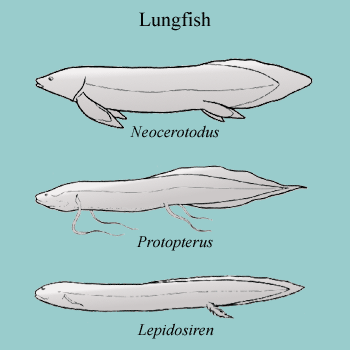
 |
The low oxygen content of some aquatic habitats (See Ch. I) has provided strong selection pressure for air breathing in fishes. In all cases of air breathing, the key is bringing oxygen rich air in contact with a highly vascularized organ having a large surface area so that diffusion can occur. Many different fishes have evolved the ability to use the oxygen in the air through a variety of specific adaptations.
The gills (knifefish), skin (eels), head cavities (labyrinthine fishes, e.g. Siamese fighting fish), and even the gut (loaches) have been employed to respire air, but the most common adaptations involve the physostomous gas bladder. Gas bladders have been adapted for oxygen uptake in bichirs (Polypterus), gars and bowfin (holosteans), primitive bony tongues (osteoglossoids), and mudminnows (Umbra). [An Example] The most highly developed gas bladder-lung, however, is found in the lungfishes.
The lungfishes (subclass Dipnoi) comprise three genera: the Australian lungfish (Neoceratodus), the African lungfish (Protopterus), and the South American lungfish (Lepidosiren). The African and South American lungfishes have evolved air breathing as a way of surviving seasonal dry spells and are able to remain alive, buried in the mud, for months. During this period of estivation, they breathe air through vents into their "cocoons". In the rainy season when they become free living again, they continue to rely on lungs rather than gills as a primary means of respiration.
The lung in lungfish does not have a muscular diaphragm to move air in and out. There is sacculation in the interior of the lung to increase surface area for diffusion, however, this does not reach the level of development of mammalian alveoli. As discussed earlier (See Ch. IVB), lungfish have special adaptations of blood circulation for air breathing.
|
|
Navigation Hint: Press "Alt" and right or left keyboard arrows to move forward and back.